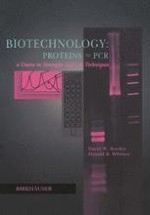1995 | OriginalPaper | Buchkapitel
Isolation and Preparation of Nucleic Acids
verfasst von : David W. Burden, Donald B. Whitney
Erschienen in: BiotechnologyProteins to PCR
Verlag: Birkhäuser Boston
Enthalten in: Professional Book Archive
Aktivieren Sie unsere intelligente Suche, um passende Fachinhalte oder Patente zu finden.
Wählen Sie Textabschnitte aus um mit Künstlicher Intelligenz passenden Patente zu finden. powered by
Markieren Sie Textabschnitte, um KI-gestützt weitere passende Inhalte zu finden. powered by
Before anything can be constructed, it is first necessary to gather the building materials, and, therefore, harvesting genomic DNA is a prerequisite for cloning. Normally two types of DNA are required for cloning, namely, the source DNA containing the targeted gene (that which is to be cloned), and the vector (a DNA molecule that carries the target). The source or genomic DNA can be from any organism or DNA virus. The vector, on the other hand, is a specially designed DNA molecule derived from either a bacteriophage, a plasmid, or some combination of both. As we shall see, the vector will serve as a carrier for the genomic DNA fragments.Methods for isolating nucleic acids depend on its source. It generally involves collecting cells or tissues, disrupting the cells with enzymes and/or detergents, separating the nucleic acids from other biomolecules and cellular debris, and finally concentrating and/or drying the nucleic acid. The complexity of isolating DNA differs depending on the source. Viral DNA simply requires stripping away the protein coat with an organic solvent (e.g., phenol and chloroform), while plant cells first require removal of the thick cell wall by physically pulverizing the cells (Table 8.1).Several different schemes can be used for the cloning of the MEL1 gene encoding α-galactosidase. If the complete gene is to be cloned, then the genomic DNA must be isolated. This is in contrast to isolating yeast mRNA and synthesizing and cloning cDNA. This chapter will examine the means of isolating nucleic acids, measuring the yield, and techniques for their storage. The experimental focus will be on the isolation of genomic DNA from the yeast Saccharomyces carlsbergensis (source) and plasmid DNA (vector) from Escherichia coli. The yeast is the source of the MELI gene that encodes α-galactosidase.
